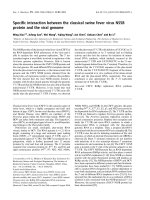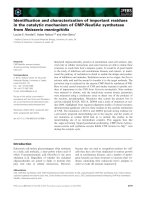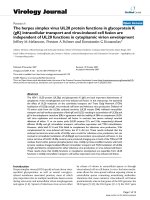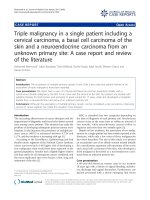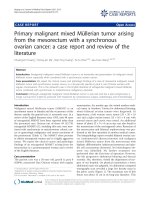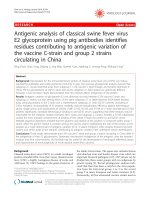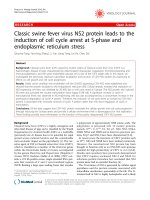Constructing the cd2v (from african swine fever virus) plant based vectors and detecting of transient expression of cd2v protein in nicotiana benthamiana
Bạn đang xem bản rút gọn của tài liệu. Xem và tải ngay bản đầy đủ của tài liệu tại đây (2.32 MB, 64 trang )
VIETNAM NATIONAL UNIVERSITY OF AGRICULTURE
FACULTY OF BIOTECHNOLOGY
GRADUATION THESIS
TITLE:
CONSTRUCTING THE CD2v (FROM AFRICAN
SWINE FEVER VIRUS) PLANT-BASED VECTORS
AND DETECTING OF TRANSIENT EXPRESSION OF
CD2v PROTEIN IN NICOTIANA BENTHAMIANA
HANOI, 03 /2021
VIETNAM NATIONAL UNIVERSITY OF AGRICULTURE
FACULTY OF BIOTECHNOLOGY
GRADUATION THESIS
TITLE:
CONSTRUCTING THE CD2v (FROM AFRICAN
SWINE FEVER VIRUS) PLANT-BASED VECTORS
AND DETECTING OF TRANSIENT EXPRESSION OF
CD2v PROTEIN IN NICOTIANA BENTHAMIANA
Student’s name
: Vu Duy Thai Son
Department
: Biotechnology
Supervisor
: Assoc. Prof. Pham Bich Ngoc
Msc. Ho Thi Thuong
Co-supervisor
: Msc. Nguyen Quoc Trung
HANOI, 03 /2021
STATEMENT OF ORIGINAL AUTHORSHIP
The work contained in this thesis has not been previously submitted to meet
requirements for an award at this or any other education institution. To the best of my
knowledge and belief, the thesis contains no material previously published or written by
another person except where due reference is made.
Signature:
Date:
i
ACKNOWLEDGEMENTS
First and foremost, my sincere thanks goes to the Department of Applied DNA
technology- Institution of Biotechnology- Vietnam Academy of Science and
Technology and Faculty of Biotechnology- Vietnam National University of Agriculture
for giving me a chance to do this thesis and support me all the time during the process.
Secondly, I would like to thank my principal supervisor, Assoc/Prof. Pham Bich Ngoc,
and co-supervisor Nguyen Quoc Trung for their ongoing support and suggestions
through my graduation thesis and most profoundly, Mrs.Ngoc had accepted me from the
first time after I decided to leave the previous lab. Moreover, I extend deep thanks to
Mrs. Ho Thi Thuong, who guided me throughout all sectors of my thesis in particular,
and so far, my research direction in general. Without her, this project would not have
been done.
I also wish to express my appreciation and gratitude to my colleagues who, through
their ideas, suggestions, and criticisms, all in order to improve my thesis. This thesis,
like any other, would not have been possible without the involvement and support of
Ms. Trinh Thai Vy, Ms. Nguyen Thi Tra, Mr. Ngo Hong Duong, they have all earned
my deepest gratitude, giving me many guidance to help me from beginner to premature
in research aspects and my skills in research almost improved from their support.
I would like to thank all Staff and students at the Faculty of Applied DNA
technology, Vietnam Academy of Science and Technology, who have had to put up with
me going through all kinds of emotional swings also deserve my thanks. They were all
very friendly and helpful to me, I was so lucky to study in a great working environment.
This thesis was financially supported by Vingroup Innovation Foundation (VINIF) for
project named: “Study on expression and evaluation of immunogenicity of several plantbased recombinant antigens of African Swine Fever virus for subunit vaccine
development” and project code: VINIF.2020.DA22.
Last, but not least, I express my great gratitude for my family and friends for all
their help, encouragement through all these years.
ii
TABLE OF CONTENT
STATEMENT OF ORIGINAL AUTHORSHIP .............................................................i
ACKNOWLEDGEMENTS ........................................................................................... ii
TABLE OF CONTENT ................................................................................................ iii
LIST OF ABBREVIATION...........................................................................................vi
LIST OF TABLES ....................................................................................................... vii
LIST OF FIGURES ..................................................................................................... viii
ABSTRACT ...................................................................................................................ix
PART I. INTRODUCTION ............................................................................................ 1
PART 2. LITERATURE REVIEW .................................................................................3
2.1. General review .....................................................................................................3
2.2. African swine fever virus .....................................................................................4
2.2.1. Molecular biology of virus ...........................................................................4
2.2.2. Transmission and dangerous effect of the ASFV .........................................6
2.3. Many attempts for virus prevention .....................................................................8
2.4. Gene EP 402R encoded for CD2v protein .........................................................12
2.5. The transient expression for production of subunit vaccines in plants and
potential for their application ....................................................................................15
PART III. MATERIALS AND METHODS .................................................................17
3.1. Materials .............................................................................................................17
3.1.1. Vectors and genes .......................................................................................17
3.1.2. Primers ........................................................................................................17
3.1.3. Media ..........................................................................................................18
3.1.4. Antibiotics ...................................................................................................18
iii
3.1.5. Commercial kits .......................................................................................... 18
3.1.6. Bacteria and plant .......................................................................................18
3.1.7. Antibody .....................................................................................................18
3.1.8. Chemicals agents and technique machines .................................................18
3.2. Methods ..............................................................................................................19
3.2.1. Amplification of the EP402R gene encoding the CD2V protein of the
ASFV virus ...........................................................................................................19
3.2.2. DNA purification method ...........................................................................20
3.2.3. Plasmid extraction method ..........................................................................20
3.2.4. Digestion method ........................................................................................20
3.2.5. Ligation method .......................................................................................... 21
3.2.6. Transformation into E.coli XLI Blue by heat shock method......................21
3.2.7. Transformation into AGL1 by electroporation method .............................. 22
3.2.8. Colony PCR method ...................................................................................22
3.2.9. Transient expression of recombinant protein in the leaf of N. benthamiana
by Agro-Infiltration methods ................................................................................23
3.2.10. Test the transient expression of CD2V protein by Western blot ..............23
PART IV. RESULTS AND DISCUSSION ..................................................................25
4.1. Results ................................................................................................................25
4.1.1. Amplification of the EP402R gene encoding the CD2V protein of the
ASFV virus ...........................................................................................................25
4.1.2. Construction of the cloning vectors that contain the gene encoding for
CD2V protein of ASFV ........................................................................................26
4.1.3. Construction of the expression vectors that contain the gene encoding
CD2V protein of ASFV ........................................................................................29
4.1.4. Transformation into A. tumefaciens AGLI .................................................33
iv
4.1.5. Transient expression of recombinant protein in N. benthamiana by AgroInfiltration methods ............................................................................................... 35
4.1.6. Evaluation the transient expression of CD2V protein by Western blot .....37
4.2. Discussion ..........................................................................................................40
PART V. CONCLUSION AND SUGGESTION .........................................................43
5.1. Conclusion ..........................................................................................................43
5.2. Suggestion ..........................................................................................................43
REFERENCES ..............................................................................................................44
APPENDIX ...................................................................................................................47
v
LIST OF ABBREVIATION
µL
microlitre
AGLI
A.tumefaciens
bp
Base pair
Carbe
Carbenicilin
CD
Cytoplasmic domain
DNA
Deoxyribonucleic acid
dNTP
Deoxynucleoside triphosphate
dsDNA
Double DNA
E.coli XLI Blue
Escherichia coli XLI Blue strain
ED
Extracellular domain
IgG antibody
Goat anti-Mouse IgG (H+L) Secondary Antibody, HRP’
Kana
Kanamycin
L
litter
LB
Luria-Bertani broth
mg
Mini gram
mins
minutes
mL
milliliter
PCR
Polymerase Chain Reaction
RE
Restriction enzyme
Rifa
Rifampicin
rpm
revolutions per minute
s
second
SP
Signal peptide
TAE
Tris – acetate – EDTA
TM
Transmembrane region
w/v
Weight/volume
vi
LIST OF TABLES
Table 2.1 The summary of several previous researches in relevant protein antigen ....11
Table 3.1 The list of primers for amplification of targeting region .............................. 17
Table 3.2 PCR components and process .......................................................................19
Table 3.3 Components for DNA digestion for cloning construction ........................... 21
Table 3.4 Components for DNA ligation for cloning construction .............................. 21
Table 3.5 PCR components and process for colony PCR of cloning construction ......22
vii
LIST OF FIGURES
Figure 2.1 Structure of the extracellular ASFV and virion egress from cells. (A)
Electron microscopy image of the extracellular ASFV particle. (B). Electron
microscopy image of ASFV virions emerging from infected cells.. ............................... 5
Figure 2.2 2D Schematic representation of ASFV CD2v
( .........................................................................13
Figure 4.1 The diagram depicts a general strategies of CD2v protein construction and
expression process in plants .......................................................................................... 25
Figure 4.2 PCR products of 4 CD2v structures ≈ 1083 bp, ≈ 1063 bp, ≈ 550 bp, ≈ 300
bp, respectively ..............................................................................................................26
Figure 4.3 Schematic representation of cloning vector construction ........................... 26
Figure 4.4 The electrophoresis results of colony PCR demonstrated successful
plasmid transfer into XLI Blue in the cloning construction process ............................. 27
Figure 4.5 The results of double digestion with BamHI and PspOMI to check for the
presence of the desired gene CD2v in the cloning plasmid. .........................................29
Figure 4.6 Schematic representation of expression vector construction ......................29
Figure 4.7 Single digestion with restriction enzyme HindIII of 4 different CD2v
constructs .......................................................................................................................31
Figure 4.8 The electrophoresis results of colony PCR demonstrated successful
plasmids transfer into XLI Blue in the expression construction process ......................32
Figure 4.9 The results of single digestion with NotI to check for the presence of the
desired gene CD2v.........................................................................................................33
Figure 4.10 The electrophoresis results of colony PCR demonstrated successful
plasmid transfer into AGLI ........................................................................................... 35
Figure 4.11 Picture depicting the physical state of N. benthamiana transformed by
AGLI which contains transgenic plasmids CD2v of 4 constructs................................. 36
Figure 4.12 Western-Blot results with crude extract were electrophoresis on SDS PAGE gel and detected by Cmyc antibodies. ................................................................ 37
viii
ABSTRACT
African swine fever (ASF) is one of the most dangerous infectious diseases in
pigs with a rapid spread, mortality up to 100%. The research and development of
vaccines against African swine fever virus (ASFV) is urgent and needs to be promoted.
Due to the complex nature of the virus and the large genome, so far the development of
vaccine against African swine fever is challenge and currently, there is no commercially
available vaccine against African swine fever.
Recently, a candidate of live attenuated vaccine ASFV-G-ΔI177L produced in
mammalian cells induced a strong virus-specific antibody response, and a sterile
immunity against the ASFV Georgia isolate, the method to generate and produce the
live attenuated vaccine ASFV-G-ΔI177L is quite complicated and expensive when
compare to other strategies for vaccine development. Few subunit vaccines showed a
patial protection against exposure to virulent strains of ASFV. Identification of the
ASFV antigens and epitopes responsible for induction of relevant immune responses is
key to develop effective vaccines against ASFV. CD2v is one of the strategically
important proteins for the production of vaccine subunit protein. The process of creating
subunit vaccines derived from plants brings many advantages because of its safety for
the environment as well as animals and humans; simple process, easy to increase
production scale, well- respond promptly when there is a risk of pandemic outbreak
whereas the price will also would be lower than traditional vaccine manufacturing
technologies.
In this research, we collected a DNA sequence that encodes for CD2v protein of
ASFV strain isolated in Vietnam, codon optimized commercially in tobacco, then
artificial synthesized and inserted in a pUC57 vector. Four different DNA regions that
encode for full CD2v protein and truncated CD2v proteins (CD2v without signal
peptide, CD2v cytoplasmic domain and CD2v extracellular domain) were amplified by
PCR using different specific primers. These PCR products were then inserted in a
cloning vector pRTRA-CaMV35S-H5-GCN4pII-cmyc-his-KDEL) via the BamHI and
PspOMI sites. The resulting expression cassette was inserted into the expression vector
pCB301 via HindIII cleavage, then transformed into the Agrobacterium tumefaciens. To
express the CD2v recombinant proteins in planta, the agroinfiltration protocol was
ix
performed to transform A. tumefaciens carrying recombinant plasmids into Nicotiana
benthamiana. The expression of CD2v proteins in planta were detected by Western blot.
As a result, the expression of full length CD2v protein was not detected.
However, the truncated CD2v protein without signal peptide was slightly expressed in
Nicotiana benthamiana, while truncated CD2v protein containing cytoplasmic domain
and truncated CD2v protein containing extracellular domain was strongly expressed.
The above results are considered as the scientific foundation for the production of
antigens in plant systems, the potential for developing new systems with low production
costs, while in a short time, making great contributions to innovative medicine.
x
PART I. INTRODUCTION
African swine fever is one of the most dangerous infectious diseases in pigs with
a rapid spread, mortality up to 100%. From 2016 to 5/2019, the disease appeared in over
59 countries around the world, including Vietnam. Currently, there have been many
researches to develop vaccines to prevent African swine fever such as DNA vaccines,
inactivated vaccines, and live attenuated vaccines. While the inactivated vaccine in
ASFV has not been shown to provide protective efficacy, there is little concern (Stone
& Hess, 1967). Development of a subunit vaccine for ASFV prevention by expressing
recombinant expression of some ASFV antigens has been studied. ASFV's identification
of the antigens and epitopes responsible for stimulating a good immune response is seen
as key to the development of an effective subunit vaccine against ASFV.
CD2v protein is one of the viral envelope proteins, which plays an important role
in viral transmission and replication. CD2v is the ASFV haemagglutinin and has been
implicated previously in protective immunity. CD2v/ EP402R proteins may be
important for protection against ASFV infection (Burmakina, G et al., 2016). Expression
of vaccine subunit protein produced on plant systems is still a relatively novel approach
for vaccine innovation. The potential of plant-based vaccine is to bring relatively large
benefits compared to other systems such as low cost, lower time consuming in
production and promptly respond to the rapid change of the virus. Therefore, for all
above reasons, I proposed the research: constructing the CD2v (from African Swine
Fever Virus) plant-based vectors and detecting its transient expression in Nicotiana
benthamiana.
The major aim of the research is to construct the plant-based vectors containing
DNA sequences encoding full and truncated CD2v protein of African Swine Fever Virus
(ASFV) isolated in Vietnam and examine the transient expression of CD2v protein in
Nicotiana benthamiana by Agro-infiltration methods. The analysis results of this
research will be used for evaluation of biological characteristics of ASFV and
potentially contribute to protein subunit vaccine production in the future.
Several hypotheses and requirements could be taken into considerations to
answer for the research. Firstly, the information should be collected including: DNA
sequence encoding CD2v protein of ASFV virus strains circulating in Vietnam, codon
1
optimization for protein expression in Nicotiana benthamiana and artificial synthesis.
Secondly, the experiment is conducted begin with constructing the plant-based vectors
carrying regions encoding ASFV CD2v antigens and constructing Agrobacterium
strains carrying corresponding vectors, ending with examining the transient expression
of ASFV CD2v protein in Nicotiana benthamiana.
2
PART 2. LITERATURE REVIEW
2.1. General review
Animal diseases are now putting a threat to animal health, food safety, national
economy and environment. African swine fever is one of the most devastating viruses
affecting pigs and wild suids due to the lack of vaccine or effective treatment (Axel
Karger et al., 2019), with a rapid spread, the mortality up to 100%. ASFV is endemic in
most sub-Saharan countries, but since its introduction in Georgia (2007), ASFV has
spread quickly to other neighboring countries in Europe and Asia. This is of particular
concern in the case of China, producing half of the world’s pig population, where it was
first reported in 2018. From 2016 to 5/2019, the disease appeared in over 59 countries
around the world. On February 19, 2019, the Ministry of Agriculture and Rural
Development officially announced that African swine fever (ASF) had entered Vietnam
and informed the first outbreaks in the 2 northern provinces of Vietnam. African swine
fever is spreading on a large scale, as of 9/2019 the disease has spread across the country
in 63 provinces and cities, causing localities to destroy over 4.4 million pigs.
According to Le Van Phan and his co-worker (2019), the first identification in
East Africa in the early 1900s, ASF spread to Kenya (1920s), transcontinental outbreaks
in Europe and South America (1960s) and Georgia (2007) and finally acute pandemics
were reported in China (2018). In more details, during January 2019, a disease outbreak
was reported at a family-owned backyard pig farm in Hung Yen Province, Vietnam. The
farm, ≈50 km from Hanoi and 250 km from the China border, housed 20 sows. In the
pre-stage of the outbreak, 1 piglet and 1 sow exhibited marked redness all over the body,
conjunctivitis, and hemorrhagic diarrhea. Breeding gilts demonstrated anorexia,
cyanosis, and fever (>40.5°C). Afterwards, in February, 2019, Le Van Phan and their
colleagues started to collect organs samples after confirming that the mortality rate at
this farm had surpassed 50%. Collaborating with Vietnam National University of
Agriculture, the name of virus was detected with complete genome followed in
Genbank: p10 (accession no. MK795932), p11.5 (MK795933), p12 (MK795934), p14.5
(MK795935), p17 (MK795936), p22 (MK795937), pE248R (MK795938), p30
(MK757460), p54 (MK554697), p72 (MK554698), and Cd2v (MK757459),
3
respectively. Also, the phylogenetic analysis of the major capsid protein genome was
constructed (Phan et al., 2019).
Therefore, ASF prevention strategies are important recently to avoid economic
losses worldwide. The preventive and control measurements should be recommended
and developed via intercontinent collaboration.
2.2. African swine fever virus
2.2.1. Molecular biology of virus
African swine fever is caused by the African Swine Fever Virus (ASFV). ASFV
is the only virus belonging to the Asfarviridae family. ASFV has similarities with
Poxvirus and Iridovirus, because all of them are cytoplasmic DNA viruses. Virions have
an internal core, an internal lipid membrane, an icosahedral capsid, and an outer lipid
envelope (Alonso et al., 2018).
ASFV is a large, cytoplasmic, double-stranded DNA, length approximate 170190 Kbs, encoded for about 160 proteins. Virus that replicates in cells of the
mononuclear phagocyte system, mainly monocytes and macrophages, although other
cell types can be infected, especially later during the infection; the activation of target
cells by ASFV replication plays a key role during ASFV infection, being a modulating
element of virus pathogenesis (Yolanda Revilla et al., 2017). ASFV virions are
icosahedral structures of approximately 200 nm, which are formed by concentric layers,
the internal core, the core shell, the inner membrane, the capsid, and in the extracellular
virions, the external envelope.
4
Figure 2.1 Structure of the extracellular ASFV and virion egress from cells. (A)
Electron microscopy image of the extracellular ASFV particle. (B). Electron
microscopy image of ASFV virions emerging from infected cells. (reviewed in Salas
and Andres, 2013).
The inner envelope is next to the core shell and appears as a single lipid
membrane by electron microscopy. This layer is derived from the endoplasmic
reticulum (ER), containing the viral proteins p17/D117Lp, p54/E183Lp, E248Rp and
p12/O61Rp (Salas and Andres, 2013). The capsid is the farthest layer of the intracellular
virions. The p72/B646Lp và E120Rp, B438Lp protein are the major components of the
capsomers. The outer envelope of the extracellular viral particles is taken from the
cellular plasma membrane during the budding process by which ASFV egresses from
the cell (Breeseand DeBoer, 1967; Carrascosa et al., 1984). The outer envelope contains
severals important proteins such as CD2v/EP402Rp, p12/O61Rp và p24; Core shell
contains some cleavage products of the polyprotein: pp220/CP2485Lp, p150, p37, p34,
p14, pp62/CP530Rp, p35, p15 and S273Rp; In addition to the genome, the inner core
also contains p10 / K78Rp, 104Lp, proteins and enzymes needed including RNA
polymerase to initiate viral infection. Other proteins described to be localized within the
5
virus particle are the homologue of the cellular CD2 protein, called CD2v which
mediates the hemadsorption to infected cells (Salas and Andres, 2013). ASFV
morphogenesis occurs in specialized areas of the cytoplasm, named viral factories,
which develop in infected cells near the nucleus and the microtubule organization centre.
Viral factories essentially exclude host proteins but are surrounded by ER membranes
and vimentin boxes (Heath et al., 2001).
Due to the complex nature of the virus plus with the large genome, so far there is
no vaccine to prevent African swine fever in the world. Thus, the research and
development of vaccines against African swine fever is urgent and should be promoted.
2.2.2. Transmission and dangerous effect of the ASFV
The broker of the virus from wild boars to domestic pigs is the Ornithodoros tick.
The virus mainly infects pig macrophages and causes serious epidemics of domesticated
pigs and wild boars. The African swine fever virus is spread through the respiratory and
digestive tract, through direct or indirect contact with infected objects such as: barns,
vehicles, tools, utensils, clothing and uneaten food containing infected pork (OIE, 2013).
Understand the virus evasion as well as transmission strategies, cellular
machinery such as infection, replication, and generation of virus considered as crucial
factors for future vaccines. One of the recent new approaches in understanding ASFV
virology is to analyze ASFV-infected cells or virus particles using proteomic tools like
two-dimensional gel electrophoresis, alone or in combination with mass spectrometry
(MS). In the study by Alejo and their colleagues in 2018, they analyzed the proteome of
highly purified extracellular virions from the Vero-adapted strain BA71V. Together
with immunoelectron microscopic investigations, a comprehensive atlas of the ASFV
particle was established. Moreover, Keßler showed the expression of ASFV genes
studied in 3 mammalian cell lines after infection with a recombinant derivative of the
OURT88/3 strain (Keßler et al., 2018). The cell lines (WSL-HP from wild boar, human
HEK 293, and Vero cells from Chlorocebus sabaeus) were chosen as they derive from
susceptible and non-susceptible host species. Studies of Alejo and Keßler revealed that
for most of the predicted ASFV ORFs, the existence of the corresponding protein in
mammalian cell culture could be demonstrated using MS.
6
Many attempts have been made to find the mechanism of ASFV entry. It has been
recently described that the mechanism of ASFV entry includes outer envelope
disruption, capsid disassembly, and inner envelope fusion before the viral core can be
released from endosomes. Elena G. Sánchez showed that the virus enters host cells by
receptor-mediated endocytosis that depends on energy, vacuolar pH and temperature
(Elena G. Sánchez et al., 2017). Other, more recent studies determined that viral entry
requires dynamin and is a clathrin-dependent process (Galindo et al., 2015). After
internalization, ASFV traffics through the endolysosomal system. The capsid and inner
envelope are found in early endosomes or macropinosomes early after infection,
colocalizing with EEA1 and Rab5, while at later times they co-localize with marker so
flate endosomes and lysosomes, such as Rab7 or Lamp1.
ASFV uncoating first involves the loss of the outer capsid layers, and later fusion
of the inner membrane with endosomes, releasing the nudecore into the cytosol. Early
studies described that ASFV entry is as fast as 30 min post when nearly 60% of virions
have been internalized. ASFV entry occurs rapidly, in seconds, and viral particles can
be detected as early as 1–15 min after infection inside endosomes (Cuesta-Geijo et al.,
2012).
Once introduced into the domestic pig population, ASFV can be transmitted
directly between pigs and leads to mortality rates approaching 100%. The typical clinical
signs include high fever, haemorrhagic lesions, cyanosis, anorexia, and ataxia. Different
organs show severe vascular changes in the acute and subacute forms of ASF, such as
renal petechiae and
diffuse haemorrhage in lymph nodes, pulmonary oedema,
disseminated intravascular coagulation, and thrombocytopenia (Ning Jia et al., 2017).
African swine fever virus (ASFV) is a highly contagious haemorrhagic and
transboundary swine viral disease, against which no prophylactic vaccine is
commercially available (Teshale Teklue et al., 2019), all of these just understudy and
there have several number of achievement on that. MGFs, have been reported to serve
as macrophage host range determinants and promote the survival of infected cells, and
additionally suppress type I IFN expression, recently, (Reis et al., 2016) reported that
MGF deleted ASFV based on the virulent strain Benin 97/1 showed reduced virulence
7
in domestic pigs and induced a protective response. Another main host defence strategy
against viral invasions is the elimination of infected cells through apoptosis (Teshale
Teklue et al., 2019) but the virus has been evolved to overcome apoptosis by expressing
proteins capable of competing and sequestering pro apoptotic proteins. ASFV encodes
several anti apoptotic proteins such as A179L, A224L, EP153R and DP71L and encodes
various proteins to modulate host immune responses and re programme survival of
infected cells (Neilan et al., 2002). The key features of immune evasion mechanisms are
still incompletely understood and need to be fully explored in future.
2.3. Many attempts for virus prevention
Vaccines are considered as one of the most effective ways for virus prevention.
Vaccines against ASFV has been developed to cope with dark scenario that might
happen in the future. Several strategies have evolved due to the expansion of this virus.
Inactivated vaccines are the most commonly applied vaccines and have
extensively been used to control numerous infectious diseases, however, this type of
vaccine is not always successful. Immunization of pigs with glutaral-dehyde‐fixed
ASFV infected alveolar macrophages and detergent treated antigens have been non‐
successful (Forman, Wardley and Wilkinson, 1982). Stone & Hess also demonstrated
that inactivated vaccines in ASFV have been shown to be ineffective, because they are
less interested in innovative vaccine development (Stone & Hess, 1967). Subunit
vaccines are the safest specific antigen based vaccines, and different ASF subunit
vaccines have been designed.
Innovation of a subunit vaccine for ASFV prevention by expressing recombinant
expression of some ASFV antigens has been studied. ASFV's identification of the
antigens and epitopes responsible for stimulating an excellent immune response is seen
as key for the development of an effective subunit vaccine against ASFV. Although
many studies have been conducted to develop subunit vaccines, however, the ASFV
genome contains 167 ORFs, making it difficult to select one or several potential specific
antigens.
Up to date, it has been shown that ASFV infection inside the cell is inhibited in
vitro by anti-protein p30 antibodies, whereas antibodies to p12, p72 or p54 inhibit
8
binding of the virus into the macrophage, which indicates the role of protein antigens in
the first steps of viral infection (Angulo et al., 1993; Gomez-Puertas et al., 1996).
However, pigs injected with p30 or p54 protein were not protected against the
ASF virus despite producing neutral antibodies (Gomez-Puertas et al., 1998). Injections
of p30 and p54 in combination (or in a mosaic structure), although still low, showed low
protection in pigs (Barderas et al., 2001; Gomez-Puertas et al., 1998). These results
indicated that the antigenic proteins in the antibody response do not completely
neutralize ASFV (Escribano et al., 2013). The activation of the T-cells response during
ASFV infection has also been investigated, and p32 is considered an important target
for lympho T cell (Alonso et al., 1997). Oura suggested that poor protection in pigs was
mainly due to decreased T-lymphocytes, which confirmed the important role of T cells
in protecting the body against ASFV (Oura et al., 2005).
Several ASFV proteins, such as p54, p30, pp220, pp62, p72 and CD2v have been
described to involve various steps of virus attachment and internalization. To evaluate
the immunogenicity, Gómez Puertas demonstrated that baculovirus expressed p54, p30
and p72 proteins were immunologically relevant to induce neutralizing antibodies, and
as a result, partial protection was achieved. As an example, the pigs immunized with
baculovirus expressed CD2v, p54 and p30 proteins developed neutralizing antibodies
and were protected against virulent ASFV challenge (Gómez Puertas et al., 1998).
Therefore, subunit vaccines can be taken into consideration for vaccine production in
the future. DNA vaccines also have been attempted as an alternative ASF vaccine
platform.
Other virion proteins present on the surface of intracellular mature or
extracellular enveloped virus particles may be targets for neutralization by preventing
virus entry or spread. Recently, a combined ASFV plasmid DNA (CD2v, p72, p32,
±p17) and recombinant proteins (p15, p35, p54, ±p17) have been used to immunize pigs;
however, the pigs were not protected from ASFV infection (Sunwoo et al., 2019).
A combined DNA prime immunization and recombinant vaccinia virus boost has
been used to screen immunogenic and potentially protective antigens of ASFV. Though
the vaccinated pigs developed clinical and pathological signs post‐challenge, the viral
9
loads were significantly reduced in blood and several lymphoid tissues as compared to
the control group (Jankovich et al., 2018).
Live attenuated vaccines (LAVs) empirically developed through serial passage
of viruses in vitro or non host animals have been successful to control numerous viral
diseases (Minor, 2015). To date, several virulence associated ASFV genes such as 9GL,
UK, CD2v, DP148R and MGFs have been deleted to generate attenuated ASF vaccines.
Despite these achievements, safety concerns remain to be challenging, and attenuated
ASF vaccines are still at the experimental levels (Teshale Teklue et al., 2019).
Moreover, Pham et al, 2017 showed that nanoparticles have been considered as
an interesting component for experimental vaccine formulations. The use of
nanoparticles in vaccinology is inspired by the fact that most pathogens have dimensions
in the nano-size range, mimic VLP ( virus like particle) and therefore can be processed
efficiently by the immune system, which leads to a potent immune response without any
concern about virus can be harmful or turn back into live virus because VLPs only
contain the antigen that was coated on the surface of nanoparticles, not virus genome.
Argilaguet and their colleagues investigated the creation of recombinant DNA
vaccines by cloning the genes encoding ASFV's p30 and p54 proteins in an open reading
frame with the gene segment coding for the immunoglobulin modified region that
identifies SLA-II with the goal of targeting the presentation of viral antigens. Although
specific T cells against ASFV proteins have been identified, no neutral antibody
production nor protection against virulence has been observed. Similarly, pigs
inoculated with the extracellular domain-encoding DNA of ASFV-hemagglutinin (HA),
fusing with proteins p30 and p54, enhanced cellular and humoral immune responses,
but did not protect those pigs from ASFV. However, when ubiquitin was expressed in
the same reading frame as viral coding genes, partial protection (33%) against ASFV
was acquired, corresponding to a good T-CD8 + T-cell response, when absent the
surface specific antibodies. Importantly, protection was correlated with the presence of
a T-CD8 + stimulating vaccine in febrile surviving pigs; vaccines have been the primary
target against 2 specific peptides located on hemagglutinin antigens (Argilaguet et al.,
2012; Lacasta et al., 2014).
10
Thus, the T-CD8 + cell response is crucial in protecting pigs against ASFV. The
viral target proteins for neutralization have been identified including p72 / B646Lp, p54
/ E183Lp and p30 / CP204Lp. Antibodies against p72 / B646Lp and p54 / E183Lp
inhibit viral binding to cells, while antibodies against p30 / CP204Lp inhibit viral entry.
In addition, other virion proteins present on the surface of intracellular or extracellular
mature viral particles that may be targeted for neutralization by preventing viral entry
or spread include protein CD2v / EP402R, protein p12 / O61Rp, p17 / D117L.
Table 2.1 The summary of several previous researches in relevant protein antigen
Protein
Gene
Function
Vaccine
type
Immunization
Antibodies
+
Publish
T cell
p30
CP204
Virus
DNA,
+
Gomez-
(p32)
L
infection
protein,
Puertas et
vector
al., 1998;
Barderas
et al., 2001
p54
E183L
Inner
DNA,
+
+
Gomez-
envelope
protein,
Puertas et
vector
al., 1998;
Barderas
et al., 2001
p72
B646L
Main
DNA,
+
+
Gomez-
capsid
protein,
Puertas et
vector
al., 1998;
Neilan et
al., 2004
CD2v
EP402
Outer
protein,
+
+
Escribano
(8-DR)
R
envelope
vector,
et al.,
inactivate
2013;
d
Argilaguet
et al., 2012
11
p17
Protein
D117L
I177L
Envelop
Inner
DNA,
envelope
protein
Immunity
Inactivate
regulation
d
+
+
Sunwoo et
al., 2019
+
unknown
Borca et
al, 2020
e
The recombinant subunit vaccine technology is a promising approach for
developing novel ASFV vaccines due to the advantages in safety and manufacturing.
These vaccines have been shown to be efficacious against AFSV over attenuated or
inactivated vaccines.
Most recently, according to Manuel V Borca and their colleagues reported that
the deletion of a previously uncharacterized gene, I177L, from the highly virulent
ASFV-G produces complete virus attenuation in swine. Animals inoculated
intramuscularly with the virus lacking the I177L gene, ASFV-G-ΔI177L, at a dose range
of 102 to 106 50% hemadsorbing doses (HAD50), remained clinically normal during the
28-day observational period. All ASFV-G-ΔI177L-infected animals had low viremia
titers, showed no virus shedding, and developed a strong virus-specific antibody
response; importantly, they were protected when challenged with the virulent parental
strain ASFV-G. ASFV-G-ΔI177L is one of the few experimental vaccine candidate
virus strains reported to be able to induce protection against the ASFV Georgia isolate,
and it is the first vaccine capable of inducing sterile immunity against the current ASFV
strain responsible for recent outbreaks (Manuel V Borca et al., 2020).
In this research, realizing the potential application of recombinant protein, we
propose researching the expression of protein CD2V to the immune system to develop
a novel vaccine generation.
2.4. Gene EP 402R encoded for CD2v protein
CD2v protein, also named EP402R, CD2v protein is encoded by the EP402R
gene, resembles the T-lymphocyte surface adhesion receptor CD2 and has a relative
molecular weight of 105 kDa. It is a glycoprotein which is assembled from a signal
peptide (SP), trans-membrane region (TM), and two immunoglobulin-like domains
(IG).
12
Figure 2.2 2D Schematic representation of ASFV CD2v
( />
Figure 2.3 3D structure of CD2v, constructed by SWISS-MODEL Homology
Modelling Report
The cytosolic C terminal domain of CD2v (CD2v-Ct) shares no obvious identity
of amino acid sequence with that of the cellular CD2 cytoplasmic domain. CD2v is
located around viral factories during ASFV infection, and the regulatory trans-Golgi
network (TGN) protein complex AP-1 is its target.
CD2v protein is involved in cell-cell adhesion, virulence enhancement, and
immune response modulation. Its possible role in the pathogenesis of ASFV infection,
further role in tissue tropism, immune evasion, and enhancing virus replication in the
host was demonstrated (Ning Jia et al., 2017). Also the genetic locus encoding CD2v
protein and C-type lectin proteins mediates HAI serological specificity, and ASFV
CD2v and C type lectin signature sequencing provides a simple method to group ASFV
by serotype. Thus it is readily exploitable for the study of ASFV strain diversity in nature
and lays a good foundation for eventual vaccine design (Rowlands R.J et al., 2009).
13
